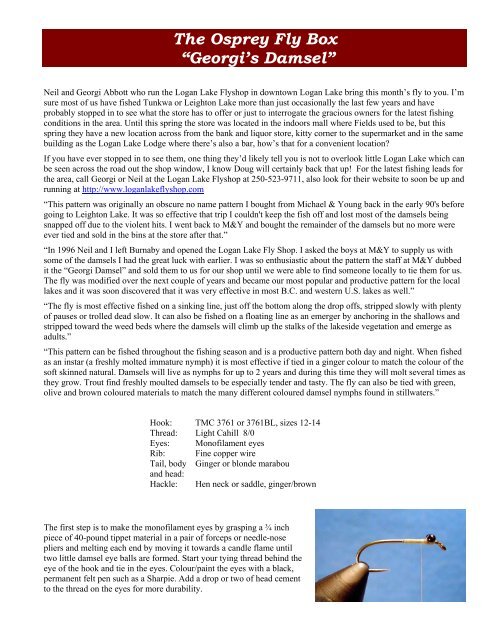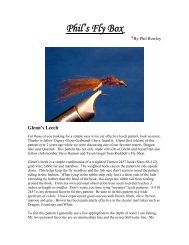The Osprey Fly Box “Georgi's Damsel” - Osprey Fly Fishers of BC
The Osprey Fly Box “Georgi's Damsel” - Osprey Fly Fishers of BC
The Osprey Fly Box “Georgi's Damsel” - Osprey Fly Fishers of BC
You also want an ePaper? Increase the reach of your titles
YUMPU automatically turns print PDFs into web optimized ePapers that Google loves.
<strong>The</strong> <strong>Osprey</strong> <strong>Fly</strong> <strong>Box</strong><br />
“Georgi’s <strong>Damsel”</strong><br />
Neil and Georgi Abbott who run the Logan Lake <strong>Fly</strong>shop in downtown Logan Lake bring this month’s fly to you. I’m<br />
sure most <strong>of</strong> us have fished Tunkwa or Leighton Lake more than just occasionally the last few years and have<br />
probably stopped in to see what the store has to <strong>of</strong>fer or just to interrogate the gracious owners for the latest fishing<br />
conditions in the area. Until this spring the store was located in the indoors mall where Fields used to be, but this<br />
spring they have a new location across from the bank and liquor store, kitty corner to the supermarket and in the same<br />
building as the Logan Lake Lodge where there’s also a bar, how’s that for a convenient location?<br />
If you have ever stopped in to see them, one thing they’d likely tell you is not to overlook little Logan Lake which can<br />
be seen across the road out the shop window, I know Doug will certainly back that up! For the latest fishing leads for<br />
the area, call Georgi or Neil at the Logan Lake <strong>Fly</strong>shop at 250-523-9711, also look for their website to soon be up and<br />
running at http://www.loganlakeflyshop.com<br />
“This pattern was originally an obscure no name pattern I bought from Michael & Young back in the early 90's before<br />
going to Leighton Lake. It was so effective that trip I couldn't keep the fish <strong>of</strong>f and lost most <strong>of</strong> the damsels being<br />
snapped <strong>of</strong>f due to the violent hits. I went back to M&Y and bought the remainder <strong>of</strong> the damsels but no more were<br />
ever tied and sold in the bins at the store after that.”<br />
“In 1996 Neil and I left Burnaby and opened the Logan Lake <strong>Fly</strong> Shop. I asked the boys at M&Y to supply us with<br />
some <strong>of</strong> the damsels I had the great luck with earlier. I was so enthusiastic about the pattern the staff at M&Y dubbed<br />
it the “Georgi <strong>Damsel”</strong> and sold them to us for our shop until we were able to find someone locally to tie them for us.<br />
<strong>The</strong> fly was modified over the next couple <strong>of</strong> years and became our most popular and productive pattern for the local<br />
lakes and it was soon discovered that it was very effective in most B.C. and western U.S. lakes as well.”<br />
“<strong>The</strong> fly is most effective fished on a sinking line, just <strong>of</strong>f the bottom along the drop <strong>of</strong>fs, stripped slowly with plenty<br />
<strong>of</strong> pauses or trolled dead slow. It can also be fished on a floating line as an emerger by anchoring in the shallows and<br />
stripped toward the weed beds where the damsels will climb up the stalks <strong>of</strong> the lakeside vegetation and emerge as<br />
adults.”<br />
“This pattern can be fished throughout the fishing season and is a productive pattern both day and night. When fished<br />
as an instar (a freshly molted immature nymph) it is most effective if tied in a ginger colour to match the colour <strong>of</strong> the<br />
s<strong>of</strong>t skinned natural. Damsels will live as nymphs for up to 2 years and during this time they will molt several times as<br />
they grow. Trout find freshly moulted damsels to be especially tender and tasty. <strong>The</strong> fly can also be tied with green,<br />
olive and brown coloured materials to match the many different coloured damsel nymphs found in stillwaters.”<br />
Hook: TMC 3761 or 3761BL, sizes 12-14<br />
Thread: Light Cahill 8/0<br />
Eyes: Mon<strong>of</strong>ilament eyes<br />
Rib: Fine copper wire<br />
Tail, body<br />
and head:<br />
Ginger or blonde marabou<br />
Hackle: Hen neck or saddle, ginger/brown<br />
<strong>The</strong> first step is to make the mon<strong>of</strong>ilament eyes by grasping a ¾ inch<br />
piece <strong>of</strong> 40-pound tippet material in a pair <strong>of</strong> forceps or needle-nose<br />
pliers and melting each end by moving it towards a candle flame until<br />
two little damsel eye balls are formed. Start your tying thread behind the<br />
eye <strong>of</strong> the hook and tie in the eyes. Colour/paint the eyes with a black,<br />
permanent felt pen such as a Sharpie. Add a drop or two <strong>of</strong> head cement<br />
to the thread on the eyes for more durability.
Tie in a small clump <strong>of</strong> marabou right behind the eyes. <strong>The</strong> tail should be<br />
approximately the same length as that <strong>of</strong> the hook shank. You can tear<br />
the tail to get the right length.<br />
With your tying thread behind the eyes, tie in the fine copper wire on the<br />
under-side <strong>of</strong> the hook. Secure the wire to the back <strong>of</strong> the hook shank.<br />
With your thread still at the end <strong>of</strong> the shank, tie in the long strands <strong>of</strong><br />
marabou for the body, be careful not to use to much, you want to have a<br />
nice slender body.<br />
Wrap the marabou forward to create the body. Counter-wrap the fine<br />
copper wire forward for the rib. Tie <strong>of</strong>f and trim the excess <strong>of</strong> both<br />
materials.<br />
Tie in the hackle right behind the mon<strong>of</strong>ilament eyes. Take 2 turns <strong>of</strong> the<br />
hackle, then tie <strong>of</strong>f and trim the rest <strong>of</strong> the feather.<br />
Tie in another small bundle <strong>of</strong> long marabou fibers where the hackle is<br />
wrapped. Form a nice little head/thorax by wrapping around the<br />
mon<strong>of</strong>ilament eyes. Tie <strong>of</strong>f and trim the marabou behind the eye <strong>of</strong> the<br />
hook. Whip finish, trim, and apply head cement.<br />
<strong>Fly</strong>, photos, and instructions by Doug Wright




